Artistic Pursuits
Huygens' artistic interests laid not only in painting but in classical architecture, numismatics and horticulture, but in sculpture as well. In 1641, the sculptor François Dieussart (c. 1600–1661)See Frits Scholten, "Sir Constantijn Huygens and François Dieussart, a portrait observed," The Sculpture Journal, published by the Public Monuments and Sculpture Association, London, 1997, 7–15. arrived at The Hague from England with a letter of recommendation from the court painter of King Charles I, Gerrit van Honthorst (1592–1656), addressed to Constantijn Huygens. This introduction not only served to secure Dieussart a good reception at the Hague court, but initiated a relationship of mutual interest and respect between Huygens and Dieussart. The timing of Dieussart's arrival was particularly favorable. After the death of Hendrik de Keyser (1565–1621) in 1621 (the sculptor of the famous tomb for William of Orange in the Nieuwe Kerk in DelftWilliam of Orange was buried in the Nieuwe Kerk in Delft following his assassination. His tomb is a grand monument that serves as a mausoleum for him and his descendants. The tomb is located in the choir of the church and is one of the most important historical monuments in the Netherlands. The tomb is a masterpiece of Renaissance architecture and sculpture. It was designed by Hendrick and Pieter de Keyser, renowned architects and sculptors of the time. The tomb is characterized by its elaborate decoration and intricate details and is rich in symbolism, with allegorical figures representing various aspects of William of Orange's life and achievements. It also includes sculptures of his descendants, symbolizing the continuation of his legacy.), no sculptor had emerged to satisfy the increasing demands both of the court and the culturally sensitive élite of the nobility or wealthy burghers.
Dieussart's arrival was especially welcomed by Huygens who had been charged to promote the architectural projects of the House of Orange maintaining close contact with the artists and architects involved. At the same time he entertained a keen interest in the tenets of classical architecture (particularly those of Vitruvias (c. 80–70 BC–after c. 15 B.C.), and he was the first in Holland to put these rules into practice (see his house at "Het Plein" and later his country estate "Hofwijck") (fig. 1). Thus, Huygens had for the first time an opportunity to commission a piece of sculpture which answered his classical ideal.
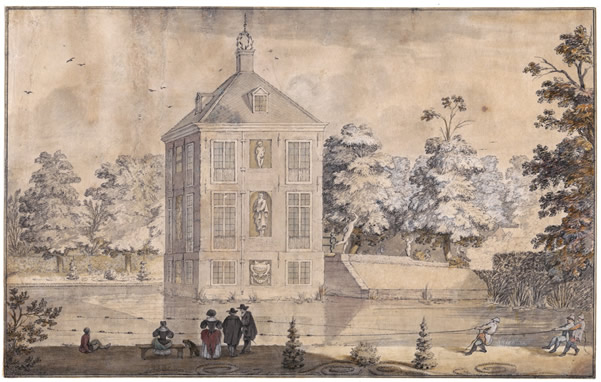
Attributed to Isaac de Moucheron
c. 1710
Colored drawing
Huygens Museum Hofwijck
On the other hand, Huygens played a fundamenta role in obtaining stadtholder commissions for Dieussart. Huygens introduced Dieussart to Frederik Hendrik and his wife Amalia van Solms (1602–1675), and the first fruit of their collaboration was a bust of Frederik Hendrik (1641). Larger and smaller commissions followed, e.g. four life-sized, full-length portraits of the stadtholders, intended for the Oranjezaal (Orange Hall) of the Palace Huis ten Bosch. But Dieussart refused to depend exclusively on the court, and joined the Guild of Saint Luke in The Hague, which allowed him to place his work on the open market and to have pupils, a significant source of income for artists in those times. During this period, Dieussart received a commission for a marble wall monument to the nobleman Arent van Dorp (1528–1600) and his daughter Josina (d. 1646), for the Klosterkerk in The Hague, which was presumably made soon after Josina's death. It is still to be seen at the Klosterkerk.
As we learn from Huygens' autobiography, he had not only a theoretical interest in sculpture but an active one as well, particularly in making medals and commemorative coins. He wrote:
In one way or another I became interested in bronze and lead coins, of which I made casts. When, in the end, I had enough of busying myself with the work of others I went on to making originals myself. It is with some pride that I allowed myself to be guided in this by the example, amongst others, of my fellow townsman Janus Secundus of The Hague. ... Here too the injustice of fate thwarted my ardent enthusiasm. Out of consideration for my sensitive eyes I had to drop this enjoyment at the stage of breast-feeding, as it were…So there are but very few medals from my hand which have survived, but for what remains, the maker does not have to feel ashamed in front of connoisseurs.Constantijn Huygens, Mijn jeugd (translation C. L. Heesakkers), Amsterdam 1987, 95, see See Frits Scholten, "Sir Constantijn Huygens and François Dieussart, a portrait observed," The Sculpture Journal, published by the Public Monuments and Sculpture Association, London, 1997, note 25 15.
A number of exceptionally interesting notes have survived in Huygens' papers, including detailed recipes for making modeling wax and casting plaster, as well as for the casting of medals in tin, lead, bronze and silver. These notes attest to his interest in medals and their manufacture, but unfortunately Huygens' poor eyesight prevented him from pursuing and mastering the art of the medallist.
Shortly before Dieussart's departure from The Hague in 1651, he presented Huygens a precious oval portrait medallion in marble showing Huygens in profile. In this portrait, Huygens is depicted in a profile view, which was a classical and artistic convention in portraiture. It allows for a detailed rendering of the subject's facial features and is often used to capture the likeness and character of the individual. Such medallions were a common form of portraiture in the Renaissance and Baroque periods, often used to commemorate and honor notable individuals. At that time it was still unusual for sculptured portraits to be executed in profile, but Huygens himself may have suggested this form. This unique gift testifies the special relationship between Dieussart and Huygens, although nothing is known of Huygens' reaction to the medallion although it can be safely assumed that he felt especially honored by it.
Constantijn Huygens as a Garden Architect
In 1639, after two years as a widower, Huygens acquired a piece of land from Jacob van Adrichem on the 25th December along the Vliet canal in Voorburg, near The Hague, with the intention of building a country estate, a buitenhuis, which he called "Hofwijck" (fig. 1, 2, 3 & 4). The word Hofwijck covers the meaning of a "place"' (wijck) with a "garden" (hof) as well as a place where one could "avoid" (wijck) the "court" (hof) of Orange. This piece of land stretched all the way from the Vliet to the Lijtwech, now named the Prinses Mariannelaan. The land is dissected by the Heerwech, now named the Westeinde. There, with the assistance of Jacob van Campen (1596–1657), he had the chance of a lifetime to integrally realize his ideas of classical architecture inspired by Vitruvius in his famous De architectura (fig. 2).
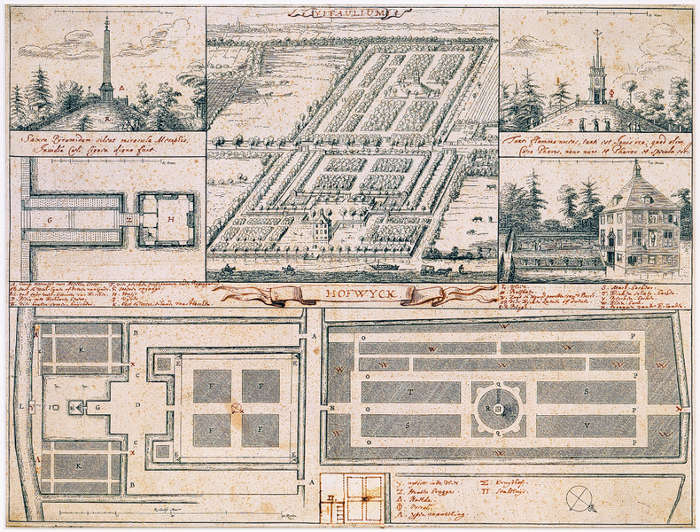
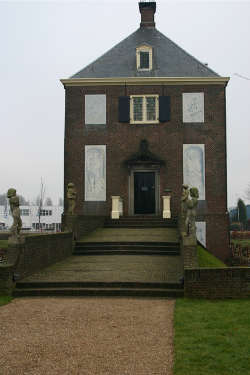
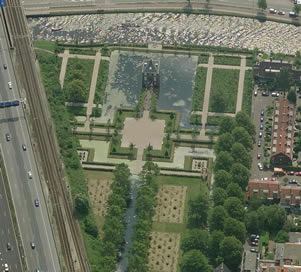
Click on the image above to view a large view of Hofwijck seen with the aid of Microsoft's Live Search Maps. Although a modern six-lane highway passes within yards, this enchanting place still preserves much of it original charm.
Some years before Huygens made a Dutch translation of Vitruvius' work,See Frits Scholten, "Sir Constantijn Huygens and François Dieussart, a portrait observed," The Sculpture Journal, published by the Public Monuments and Sculpture Association, London, 1997, 8. together with Count Johan Maurits van Nassau-Siegen (the owner of the Mauritshuis, neighbor and friend of Huygens), Huygens carefully planned the garden (with a little house as its "head") following the proportions of what was considered the greatest work of art—the human body whose essential symmetry served as a symbol for the harmonious symmetry of the universe as a whole. Constantijn found confirmation of these views in the Bible's tale of creation where God created man in his image and likeness. Unfortunately, the ground between Lijtwech and Heerwech turned out to be poor, sandy soil, so bad in fact, that the newly planted oak trees died in droves. Constantijn interpreted this setback as the devil striving to prevent the return of paradise on earth but Post advised to simply dig up the devilish soil and remove it. The bad sand was used to create a hillock with a "green cap"of grass, wild flowers and daisies. This high hill also afforded a delightful view of the wide surroundings, reaching all the way to the coast at Scheveningen. The soil between Heerwech and the Vliet was instead rich clay, and was destined to become the tame garden. The house would be built right next to the Vliet and surrounded by a pond, alike to a stone jug in a cool barrel of water. Thus to a good extent, nature itself determined the basic design of the estate.
Hofwijck was an utopia of hospitality, entertainment and reflection. One could engage in archery at the foot of the mountain, pick fruits in the orchard or "bowl" on the lawn of the "bolbaen" along the Vliet. Music and singing were at home in the state room or garden. The meticulous Huygens had planned Hofwijck employing sizes and proportions in the rooms that would optimize the sounds of a string instrument. In February 1642, Huygens celebrated the festive opening of "Hofwijck," also called in the Latin form "Vitaulium," together with his family and many friends. Some lines from his later written poem about "Hofwijck" (fig. 6) speak well for Huygens' sincere and generous hospitality:
While walking, meditating, reading or talking with his friends in a such a harmonious environment, Huygens searched for an inner peace and harmony which he longed for his entire life. And it was the same peace and harmony that he wished to bestow on his visitors in the midst of this little "Garden Eden."
Twee poorten zeggen meer: onthaal ik vriend of gast,
dan is 't niet door één deur, 't is door twee open deuren
De ruime ingang toont wat binnen zal gebeuren,
en dat de vrienden op mijn brood en op mijn wijn,
niet half, niet heel, niet één-, maar tweemaal welkom zijn.
(Two Gates speak of more: be I greeting friend or guest
't is not by one door yet by two open doors;
the spacious entrance shows what is to happen indoors,
And that friends are welcome to my bread and my wine,
not half, not whole, not once, but twice.)
(Hofwijck 1653, lines 1064–1068)
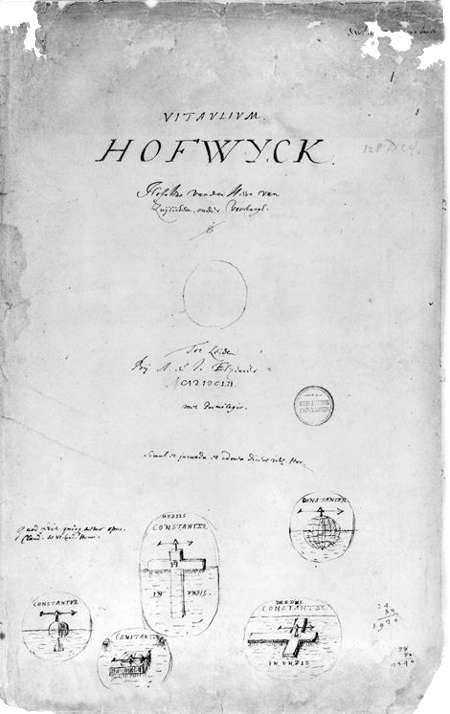
Constantijn Huygens
1653
Koninklijke Bibliotheek Den Haag
Until the end of his life Huygens spent as much time at Hofwijck as he could possibly afford away from his lifelong business. Shortly before he died, he drafted his own will and in order to safeguard the continued existence of his country estate. He stipulated that Hofwijck must remain within the family. As a consequence it became the shared property of his three surviving sons: Constantijn Junior (1628–1697), Christiaan (1629–1695) and Lodewijck (1631–1699). No part of Hofwijck was to be sold or let.
Tragedies
But the initial period of tranquility in the buitenplaats last briefly. In September 1642, his brother Maurits, secretary of the "Raad van Staate," died and left him as the head of the family. This was a blow to Huygens, and as it was often the case, he could not bring himself to write poetry in Dutch, but only in Latin. In 1644, he published a collection of Latin poetry, called Momenta Desultoria.
In 1645, the sons Constantijn (jr.) and Christiaan began their studies at the Leiden University, as their father had done 27 years earlier. The serious illness of Frederik Hendrik, Huygens' protector, and the problematic political situation caused by the English Civil War complicated Huygens' position at the court calling on him to employ his most subtle diplomatic abilities. On one hand, he was a Dutch patriot absolutely loyal to the House of Orange. On the other he had numerous English friends from his travels to England. He always felt a certain loyalty to James VI and the House of Stuart from his short contacts to the English King in 1618 and 1621.
In 1647 Frederik Hendrik died. Huygens continued to serve as confidential secretary, but his master was now the twenty-one year old son William II (1626–1650). Huygens attended in 1648 the final negotiations in Brussel which ratified the Peace of Westphalia which officially granted independence from Spain, ending the Eighty Years' War.
In 1641, William II had married Mary Henrietta Stuart (1631–1660), the eldest daughter of King Carles I (1600–1649) of England. This marriage made the relationship between the Dutch Republic and England closer but not easier. Huygens was personally worn by the drawn-out, sometimes fruitless negotiations between the two countries. At the same time he negotiated between the Prince of Orange, the Queen and the States Council which consumed almost all of his time and energy, although he always attempted to maintain a position of consistent civility to both sides.
He tried to find time writing and publishing. In 1647 a number of Huygens' musical creations, Pathodia sacra et profana, were published in Paris (fig. 7). It contains some compositions on Latin psalms as well as on French and Italian amorous worldly texts.
The work was dedicated to Huygens' best musical friend, the beautiful Utricia Ogle (1611–1674) (fig. 8 & 9), daughter of the English military governor in Utrecht, John Ogle, 1645 married to the English officer William Swann. Huygens had performed some pieces from the Pathodia with her in private circles, deeply fascinated by her superb voice, evident in the dedication ("nostra Siren") or later in his poem Hofwijck ("I heard her singing here, I think I hear her still / Out-sing the nightingale, eclipse the nightingale," lines 409–10, transl. Davidson/Van der Weel).
After ruling for only three years, William II died. With his death there began the so-called "Eerste Stadhouderloos Tijdperk" (the First Stadtholderless PeriodThe First Stadtholderless Period in the Dutch Republic (1650-1672) marked a time without a designated Stadtholder, the highest-ranking official. The absence of a Stadtholder led to a shift in power dynamics, with the republican faction gaining influence. Johan de Witt played a key role in this period, serving as Grand Pensionary of Holland. The era was marked by political tensions, foreign conflicts, and ultimately ended with the return of William III of Orange in 1672. This period had a lasting impact on Dutch politics and discussions about governance. ) lasting from 1650 to 1672. The son of William II, now William III, had been born only eight days before the death of his father. The fact, that the future of the House of Orange depended on a frail little baby meant years of oppressive anxiety for true Orangists like Huygens. It is remarkable, that despite of all the dissentions within the minute court at The Hague, Huygens could manage to write a meditative description of his beloved Hofwijck, which was completed towards the end of 1651.
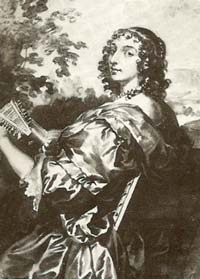
1616–1674
Drawing (bister) by
Jan de Bisschop
after a lost painting
by Caspar Netscher.
Turin, Royal Library
Her unusual first name refers to
her birthplace Utrecht.
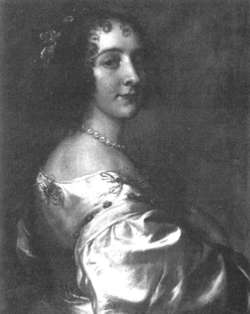
Follower of Anthony van Dyck
c. 1640– 1650
Oil on canvas
Kimbell Art Museum, Fort Worth (TX)
Apart from all the troubles in business Huygens lost a number of friends in this decade: among them Hooft in 1647, his brother-in-law Barlaeus in 1648, and even more painfully, Maria Tesselschade in 1649. The world and the friends of his youth were gone, and from this point onwards in his life, he became more and more resigned. Moreover, he had difficulties in assuring suitable careers for his sons, especially for Constantijn, for whom he could only get a relatively humble post at the court partially on account of the indifference of the Princely family. Christiaan, who continued his studies of the natural sciences in Breda, went to Paris where he became the most celebrated physicist and astronomer. Lodewijk, the third son, was able to initiate a diplomatic career in the Dutch Embassy to the English Parliament thanks to the many friendly relationships of his father with English persons of influence. Philips, the youngest and perhaps less talented of the sons, died in 1657 while attached to a diplomatic mission to Poland and Sweden. The loss caused Huygens a long, dangerous illness. He recovered very slowly, more sombre and more deeply committed to his Calvinist faith. During his father's illness Christiaan supervised the publication of a collection of Huygens' poems from the last years which appeared in December 1657 under the title De Korenbloemen van den Heere van Zuylichem ("The Cornflowers of the Lord of Zuilichem"). Huygens himself had chosen this title explaining it in a preceding poem, where he—with some understatement—compared his poems with the simple cornflowers, transient and appealing weeds, only peripheral to the business of "agriculture."
The Country Estate Immortalized: Constantijn Huygens' Hofwijck
Willemin B. de Vries: (excerpts)
"From the close of the sixteenth century onward, rich city dwellers began to have country estates built and matching gardens laid out. In parallel we find Dutch poets praising these gardens in verse for two centuries; in Dutch this genre is called hofdicht, the country house poem. The first country house poem dates from 1613, the last from 1803, the corpus containing about 125 shorter and larger poems. Nowhere in Europe did country house poetry flourish as in Holland. The tone of the genre, which was mainly pursued in the eighteenth century, was set by three famous poets in the 1650s when they immortalized their own estates in elaborate poems, all within a period of a few years.Constantijn Huygens, Vitaulium. Hofwyck. Hofstede Vanden Heere van Zuylichem Onder Voorburgh, The Hague, 1653; Jacob Westerbaen, Arctöa Tempe. Ockenburgh, The Hague, 1654; Jacob Cats, Ouderdom, Buytenleven, en Hofgedachten, op Sorghvliet, Amsterdam, 1655.
The principal classic examples of the glorification of country life were Virgil's Georgica and Horace's concise summary of motifs in the second epode, "Beatus ille." In both antiquity and the Renaissance a variety of rural activities have been described in verse in georgic-didactic poems.
At the age of forty-four, Huygens started the layout of his Hofwijck estate in the village of Voorburg, in the vicinity of The Hague. … The house is modest in size, its name is programmatic: "Away from the Court." As a number of passages of his poem testify, Huygens followed Vitruvius [(c. a 80–70 B.C.–?)] in taking the relations between the various parts of the human body as the ideal model for his estate: the house is the head, the upper garden with front yard is the upper part from the body, the road separating the two parts of the garden represents the waist, the lower garden is the lower part of the body—a microcosm reflecting the harmonious relations of the macrocosm.
What does this courtier-squire want to tell his public when he writes about his garden? … On the one hand, scholars … stress the spiritual aspect inherent in gardens. From their point of view, therefore, in this period a garden never is just a spot for sitting in the sun, but rather a place inviting meditation, cultural activities, and the reading of God's second book, nature.
I intend to show that it [the Hofwijck-poem] is a many-sided and intriguing country house poem, especially because Huygens is aware of all these possibilities and incorporates them into his poem in one way or another. My first point is that he wrote a carefully constructed text. Second, he is conscious of the literary tradition of a country life, continues it, and, third, at the same time deals with it sometimes in an ironic way. Finally, he knows the criticism directed at the display of luxury involved in the possession of a country estate and uses it in a superb manner.
In the introduction Huygens excites, fully according to the rules of rhetoric, the attention, benevolence and inquisitiveness of the reader.
A stroll through a certain territory takes time, even in fiction. In Hofwijck time plays a part at various levels. … So we, the readers, stroll with Huygens, the first-person narrator, through the estate, while evening slowly falls, and we must also be prepared regularly to leap a hundred years ahead in time in order to admire the trees in their full glory.
In contrast to the pastoral poem, the country house poem stays close to reality. War, for instance, is mentioned several times. In an extensive, moving passage Huygens recalls the struggle for freedom in the Eighty-Years' War between Spain and the Low Countries.
Paradise, the garden of Eden, is rarely far away in a garden poem. And in the country house poem, too, the garden as a second Eden is commonplace. Huygens as a Calvinist knows too well, that on this earth a garden of Eden is no longer possible: at least, he never gives Hofwijck this name in the poem. The poet amuses the reader sometimes, by thwarting expectations. For this he needs, of course, a reader who is interested in the genre.
But the other side to this existence and this genre that must be recognized, the estate as a symbol of power and opulence and the country house poem as the poetry that legitimizes it, has not yet been dealt with. The exceptional thing about Huygens is that in his poem he thematizes the possession of Hofwijck as a display of opulence. … It is his aim to give moral instruction by means of his poem. When the position of the squire is scrutinized, it is not his social status but his moral status that matters. The question of which various aspects are considered is whether the building and laying-out of an estate are pointless squandering of money out of ostentatiousness or a means of spending honestly earned money to a justifiable end? … In this view, the possession of an estate is justified. Far from having been squandered, honestly earned money has been well spent. It is not just coincidence that this subject is broached by Huygens in his poem, as at that time the display of luxury was exciting criticism. … So, contrary to what the reader might expect, Huygens does not conclude this section on a positive note. He declares human judgment to be inadequate and even leaves the possibility open that he himself might be in error. While he had first supported the propriety of his acts by a whole body of classical-humanist wisdom, quoted in the margin, in which the neo-Stoical golden mean again provides the norm, he now ends up going one step further. The "driveler" [i.e. the reader] and the poet himself are put on one line as being both nothing but blind men who are to be judged by God.
His overall view is clear enough: the proper country life serves "the recreation of the mind." The important thing is to repose in moderation, hospitality, knowledge, wisdom, piety, tolerance and merriment.
In his poem country and city are characterized by different modes of existence, that of truth and honesty as opposed to that of deceit and fraud. On the other hand, the difference is not so great after all. Country and city cannot always be distinguished, and ultimately, in the sight of God we all wander about uncertainly. Therefore, the relativizing conclusion may stand: the city is a nice place, too.
The poet has accomplished what he promised to do in his exordium: Hofwijck has been praised from beginning to end. The squire-poet, with his garden as starting point, makes his ambulation into a discourse, fit to amuse the reader and to teach him many things about country life but also about the city."
: Hunt, John Dixon, ed. The Dutch Garden in the Seventeenth Century. Dumbarton Oaks Colloquium on the History of Landscape Architecture 12. Washington D.C., 1988.
In 1660, when William III was just ten years old, his mother died. In her will, Mary Henrietta had designated her brother, King Charles II of England, as William's legal guardian, but Charles delegated this responsibility to William's paternal grandmother, Amalia of Solms, the widow of Frederik Hendrik. In the same year Orange was invaded by France, and Huygens had to undertake enormous diplomatic activities during the next years to attempt a resolution of the problem, which meant a constant traveling between Paris, The Hague and London. The only personal satisfaction in 1660 was the marriage of his daughter Susanna with her cousin Philips Doublet, son of Huygens' sister Geertruyd.
Some political accomplishment which brought a lowering of tension at the court, came from the Restoration of Charles II to the throne of England. Although Huygens finally attained a temporary resolution of the "French question" (the status of the principality of Orange in the south of France) and acted as representative of the House of Orange in 1665 in the symbolic repossession of the principality, his poems from this period, especially the very moving one Op mijen geboort-dagh ("On My Birthday") read more and more like a prayer for release from the fatigues and anxieties of his life, silently longing for death (Huygens was now 69 years old):
Hoe veel Septembers, Heer, en hoe veel' vierde dagen
Wilt ghij mij noch verdragenWat wacht ick meer op aerd, waerom en scheid' ick niet?
(How many more Septembers, and fourth days,
Lord, will you suffer me?What do I hope on earth, why not now leave?Peter Davidson and Adriaan van der Weel, A Selection of the Poems of Sir Constantijn Huygens (1596–1684) (Amsterdam: Amsterdam University Press, 1996), 178–179.)
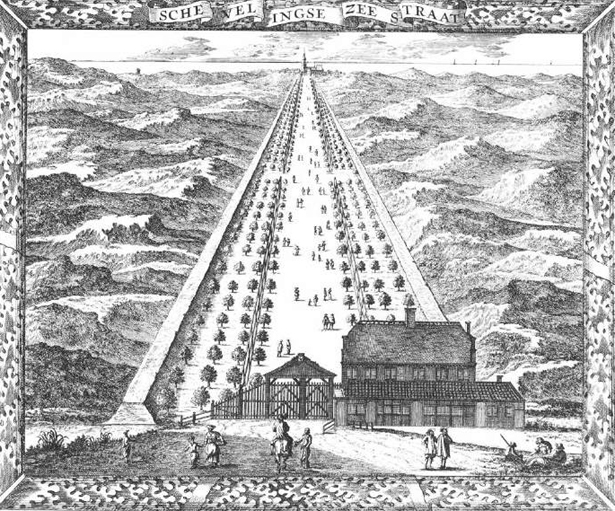
But yet another stressful decade of public life laid before him. Eighteen years ago, in 1643, Huygens had made a plan for a paved road from The Hague to the coast at the nearby Scheveningen.
Although he saw this road as a more comfortable way to the coast for the Hague citizens to enjoy the fresh air of the sea, it meant vice versa an enormous improvement for the fishermen and women as well as peasants and traveling craftsmen to carry their goods more comfortably to the markets of The Hague as the ways through the sandy soil of the dunes had been very hard and dangerous. But the officials had considerable objections at first against the plan, as the costs for the realizing where immense and had to be paid to the half by the "city" (The Hague wasn't an official city in that time, got the city rights late in 1806). Only when they had realized that the road could also be used for the Republic's troops to prevent an invasion from the sea they agreed with Huygens' plan, and the road was finally built in 1665 (fig. 10 & 11) . In 1667 Huygens celebrated his plan in an extended set of verses called Zee-straet. The poems and epigrams he wrote within the following years were gathered and added to an extended publication of his Korenbloemen in 1672, the last publication in his life.
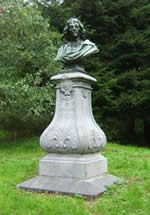
(entrance to the "Scheveningse Bosjes"), The Hague.
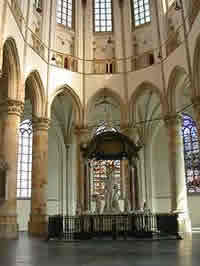
The graves of Constantijn sr. and
Christiaan Huygens (d. 1695)
had probably been on the rear wall
near the altar
The last third of this century so crucial for the development of the young Dutch Republic saw a continued degeneration of relations with the English House of Stuarts. And so in 1670 Huygens had to make a last, disillusioning journey to England in the retinue of the young Prince William III (later the King of England). But while the Prince, after a royal visit without much problems, returned to Holland in Spring 1671, Huygens had to remain in London with the thankless task of attempting to extract from the English court and parliament some of the debts which they still owed to the House of Orange, of course without success. He felt certainly very relieved when he finally could return to The Hague in October 1671. The somewhat fatalistic poem Oogentroost ("Consolation of the Eyes") written on the voyage home and addressed to his sister Geertruyd who was going blind from cataract, showed an ever more urgent desire for release, a feeling that he had outlived this time, his contemporaries and his natural span of life.
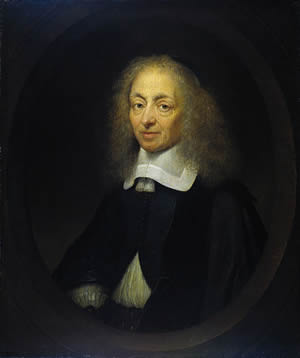
Caspar Netscher
1672
Oil on panel, 27 x 23 cm.
Huygens Museum Hofwijck
But the worst came with the year 1672, the terrible Rampjaar ("Disastrous Year"), where the United Provinces were attacked at near the same time from England, France, Münster and Cologne. This meant a dramatic decline both for the flourishing economy and the entire social and cultural life in the Republic as well as humiliating losses of territory and the payment of indemnities, which lead to the outbreak of violence and the mob murder of the raadpensionaris (Grand Pensionary) Johan de Witt (1625–1672) and his brother Cornelis. The only consolation for a loyal Orangist like Huygens could have lain in the appointment of William III as the new stadtholder and with him some restoration of Orange's former place of eminence in the life of the Republic. The Treaty of Westminster with England in 1674 and with France 1678 in Nijmegen put a temporary end to the constant warfares.
Huygens' last years were naturally less active than all those before. His relationship with William III was very distant. Although no longer personally involved in diplomatic activities surrounding the treaties with England and France he acted, as a representative of the House of Orange, in a few official functions. He was certainly very glad about the treaty with England which lead in 1677 to a new alliance between the Houses of Stuart and Orange with the marriage of William III with Mary, daughter of James, Duke of York (later James II of England).
But despite this rather positive outlook for Orange's future Huygens' life seemed rather to be marked by gentle melancholy and his longing for release. His son Constantijn (who followed his father as private secretary to William III) moved away with his family in 1680 from the great house at the Plein and most of his friends had died. He suffered deeply from this loneliness, but always tried to find some pleasures in writing poetry (1683 the extended Cluys-werck about the nature of last words, and a long autobiographical poem in Latin) or making music (although, as he wrote in a letter, he was only be able then to play some simple accompanying chords on the theorbo due to the gout in his hands). In 1682 even his little puppy "Geckie" ("Little Fool") left him. He buried it in Hofwijck, at a place near the house (fig. 14). His weary epitaph for his little Geckie reveals once again his entirely longing for an end and his disgust with the great men of the world whom he had served throughout his public life.
Myn Geckies grafschrift
Dit is mijn Hondjes Graf
Ick segger niet meer af,
Als dat ick wenschten (en de Werld waer niet bedurven)
Dat mijn klein Geckje leefde en all' de groote sturven.(My Puppy's Epitaph
This is my puppy's grave:
25 October, 1682
No more than this be said,
I'd wish (and were it so, the world were none the worse)
My little dog alive, all this world's great ones dead.)Peter Davidson and Adriaan van der Weel, A Selection of the Poems of Sir Constantijn Huygens (1596–1684) (Amsterdam: Amsterdam University Press, 1996), 9. 186-187.
His deep Calvinistic faith in the chastising and consoling Deity was his last refuge and comfort as it had always been before in so many hard times in his long life.
Constantijn Huygens died on Good Friday, the 28th of March, 1687, in his ninety-first year. One week later, he was buried in the Grote or Saint Jakobskerk (fig. 12) in The Hague in a large official funeral with fifteen black covered mourning coaches. He had "lived, as an active statesman, virtuoso, musician and poet through the whole cycle of maturing of the Dutch Republic as a unique state in Early Modern Europe, reflecting to the end the paradoxical status of his country as both a late flowering of the civic ideals of the high Renaissance and a forerunner of the liberties of the Enlightenment. … Few servants of any state can have performed their duties for so long, or with such exemplary fidelity: living his name, Constanter."Peter Davidson and Adriaan van der Weel, A Selection of the Poems of Sir Constantijn Huygens (1596–1684) (Amsterdam: Amsterdam University Press, 1996), 9. 26.
Internet resources
- Huygensmuseum Hofwijck
http://www.hofwijck.nl/hofwijck/ (Dutch)
https://huygensmuseum.nl/en/home (English) -
A Selection of the Poems of Constantijn Huygens (1596–1687) English translations © Peter J. Large, 2015
https://www.jstor.org/stable/j.ctt16f8ds6 - De gedichten van Constantijn Huygens
(the poems, in chronological order)
Leiden University, Department of Dutch Language & Literature
http://www.let.leidenuniv.nl/Dutch/
Huygens/HUYG00.html
Literature
- Colie, Rosalie L. "Some Thankfulnesse to Constantine." A Study of English Influence upon the Early Works of Constantijn Huygens. The Hague, 1956.
- Davidson, Peter, and Adriaan van der Weel. A Selection of the Poems of Sir Constantijn Huygens (1596–1687). Amsterdam: Amsterdam University Press, 1996.
- Strengholt, L. Constanter. Het Leven von Constantijn Huygens. Amsterdam, 1987.
- Alpers, Svetlana. The Art of Describing. Chicago, 1983, chapter I: "Constantijn Huygens and The New World," 1–25.
- Rasch, Rudolf. "Een raadsman voor de kunsten. Constantijn Huygens als adviseur van Frederik Hendrik." In Kunstenaars en opdrachtgevers, edited by Harald Hendrix. Amsterdam: Amsterdam University Press, 1996, 89–117. (Utrecht Renaissance Studies, 2)
- De Vries, Willemien B. "The Country Estate Immortalized: Constantijn Huygens' Hofwijck." In The Dutch garden in the seventeenth century. Dumbarton Oaks Colloquium on the History of Landscape Architecture (12, 1988, Washington DC), 81–97.
- Scholten, Frits. "Sir Constantijn Huygens and François Dieussart, a portrait observed." The Sculpture Journal, publ. by the Public Monuments and Sculpture Association London, 1997, 7–15.
- Held, Julius S. "Constantijn Huygens and Susanna van Baerle: A Hitherto Unknown Portrait." The Art Bulletin vol. LXXIII, no. 4, December 1991, 653–668.
- Noske, Frits. "Two Unpaired Hands Holding a Music Sheet: A Recently Discovered Portrait of Constantijn Huygens and Susanna van Baerle." Tijdschrift van de Vereniging voor Nederlandse Muziekgeschiedenis XLII-1, 1992, 131–140.
- Schwartz, Gary. "How Sterre came home." Schwartzlist no. 226, January 2005.
- Crawford, Tim. "Constantijn Huygens and the Engelsche Viool." Chelys, publ. by the Viola da Gamba Society of Great Britain, London, XVIII, 1989, 41–60.